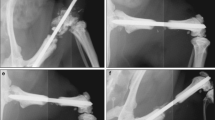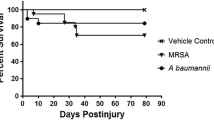Abstract
Data from civilian trauma practice would support the non-operative management of low-energy transfer ballistic wounds to bone. However, there is a paucity of data to indicate whether this would be an effective treatment for similar injuries in military casualties, in whom wounds are heavily contaminated and there is a delay to receipt of medical treatment. We created a model of ballistic wounding in the proximal tibia of pigs. Fractures were contaminated withStaphylococcus aureus. Animals were divided into two groups; Control (n = 8), received no treatment, Treatment (n = 6), received 600 mg benzylpenicillin and 500 mg flucloxacillin by intramuscular injection for seven days, commencing six hours after injury. Animals were killed 14 days after injury. Treatment with antibiotics caused a statistically significant reduction in the incidence of osteomyelitis assessed by bacteriological examination. The results have important implications for the management of low-energy transfer wounds of bone in both civilian and military casualties.
Similar content being viewed by others
References
Bowers WH, Wilson FC, Greene WB (1973) Antibiotic prophylaxis in experimental bone infections. J Bone Joint Surg [Am] 55: 795–807
Bowyer GW (1996) Management of small fragment wounds: experience from the Afghan border. J Trauma (Suppl. 3) 40: 170–172
Brown TD, Michas P, Williams RE, Dawson G, Whitecloud TS, Barrack RL (1997) The impact of gunshot wounds on an orthopaedic surgical service in an urban trauma center. J Orthop Trauma 11: 149–153
Carey ME (1996) Analysis of wounds incurred by US Army Seventh Corps personnel treated in Corps Hospitals during Operation Desert Storm, February 20 to March 10, 1991. J Trauma (Suppl. 3) 40: 165–169
Cooney W P, Fitzgerald RH, Dobyns JH, Washington JA (1982) Quantitative wound cultures in upper extremity trauma. J Trauma 22: 112–117
Cremieux AC, Carbon C (1997) Experimental Models of Bone and Prosthetic Joint Infections. Clin Inf Dis 25: 1295–1302
Curtis MJ, Brown PR, Dick JD, Jinnah RH (1995) Contaminated fractures of the tibia: a comparison of treatment modalities in an animal model. J Orthop Res 13: 286–295
Degiannis E, Levy RD, Hatzitheofilou C, Florizoone MGC, Saadia R (1996) Gunshot arterial injuries to the groin: comparison of iliac and femoral injuries. Injury 27: 315–318
Dickey RL, Barnes BC, Kearns RJ, Tullos HS (1989) Efficacy of antibiotics in low-velocity gunshot fractures. J Orthop Trauma 3: 6–10
Ellis H (1958) The speed of healing after fracture of the tibia. J Bone Joint Surg [Br] 40: 42–47
Geissler WB, Teasedall RD, Tomasin JD, Hughes JL (1990) Management of low velocity gunshot-induced fractures. J Orthop Trauma 4: 39–41
Hoffer MM, Johnson B (1992) Shrapnel wounds in children. J Bone Joint Surg [Am] 74: 766–769
Huelke DF, Darling JH (1964) Bone fractures produced by bullets. J Forens Sci 9: 461–469
Ikeda RM, Kohn M, Rosenberg ML (1997) Gunshot wounds: a public health care crisis. J Orthop Trauma 11: 147–148
Jacob E, Erpelding JM, Murphy KP (1992) A retrospective analysis of open fractures sustained by U.S. personnel during operation Just Cause. Mil Med 157: 552–556
Knapp TP, Patzakis MJ, Lee J, Seipel PR, Abdollahi K, Reisch RB (1996) Comparison of intravenous and oral antibiotic therapy in the treatment of fractures caused by lowvelocity gunshots. J Bone Joint Surg [Am] 78: 1167–1171
Rose SC, Fujisaki CK, Moore EE (1988) Incomplete fractures associated with penetrating trauma: etiology, appearance, and natural history. J Trauma 28: 106–109
Ryan JM, Cooper GJ, Haywood IR, Milner SM (1991) Field surgery on a future conventional battlefield: strategy and wound management. Ann R Coll Surg Engl 73: 13–20
Ryan JM, Rich NM, Burriss DG, Oschner MG (1997) Biophysics and pathophysiology of penetrating injury. In: Ryan JM, Rich, NM, Dale RF, Morgans BT, Cooper GJ (ed) Ballistic Trauma. Arnold, London p. 31–46
Spalding TJW, Stewart MPM, Tulloch DN, Stephens KM (1991) Penetrating missile injuries in the Gulf War. Br J Surg 78: 1102–1104
Strawitz JG, Wetzler TP, Marshall JD, Lindberg RB, Howard JM, Artz CP (1955) The bacterial flora of healing wounds: A study of the Korean battle casualty. Surgery 37: 400–407
Tong MJ (1972) Septic complications of war wounds. JAMA 219: 1044–1047
Woloszyn JT, Uitvlugt GM, Castle ME (1988) Management of civilian gunshot fractures of the extremities. Clin Orthop 226: 247–251
Worlock P, Slack R, Harvey L, Mawhinney R (1988) The prevention of infection in experimental open fractures: the effect of antibiotics. J Bone Joint Surg [Am] 70: 1341–1347
Author information
Authors and Affiliations
Corresponding author
Rights and permissions
About this article
Cite this article
Hill, P.F., Watkins, P.E. The prevention of experimental osteomyelitis in a model of gunshot fracture in the pig. Eur J Orthop Surg Traumatol 11, 237–241 (2001). https://doi.org/10.1007/BF01686897
Received:
Accepted:
Issue Date:
DOI: https://doi.org/10.1007/BF01686897




